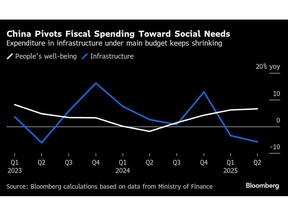
Article content
(Bloomberg) — China’s government spending has pivoted toward social welfare to a degree unseen for at least a generation, as it runs a record budget deficit with a focus on boosting consumption to cushion the blow from Donald Trump’s tariffs.
THIS CONTENT IS RESERVED FOR SUBSCRIBERS ONLY
Subscribe now to read the latest news in your city and across Canada.
- Exclusive articles from Barbara Shecter, Joe O'Connor, Gabriel Friedman, and others.
- Daily content from Financial Times, the world's leading global business publication.
- Unlimited online access to read articles from Financial Post, National Post and 15 news sites across Canada with one account.
- National Post ePaper, an electronic replica of the print edition to view on any device, share and comment on.
- Daily puzzles, including the New York Times Crossword.
SUBSCRIBE TO UNLOCK MORE ARTICLES
Subscribe now to read the latest news in your city and across Canada.
- Exclusive articles from Barbara Shecter, Joe O'Connor, Gabriel Friedman and others.
- Daily content from Financial Times, the world's leading global business publication.
- Unlimited online access to read articles from Financial Post, National Post and 15 news sites across Canada with one account.
- National Post ePaper, an electronic replica of the print edition to view on any device, share and comment on.
- Daily puzzles, including the New York Times Crossword.
REGISTER / SIGN IN TO UNLOCK MORE ARTICLES
Create an account or sign in to continue with your reading experience.
- Access articles from across Canada with one account.
- Share your thoughts and join the conversation in the comments.
- Enjoy additional articles per month.
- Get email updates from your favourite authors.
THIS ARTICLE IS FREE TO READ REGISTER TO UNLOCK.
Create an account or sign in to continue with your reading experience.
- Access articles from across Canada with one account
- Share your thoughts and join the conversation in the comments
- Enjoy additional articles per month
- Get email updates from your favourite authors
Sign In or Create an Account
or
Article content
The latest evidence arrived on Monday, when China announced it will start offering nationwide cash handouts to families as an incentive for couples to have children. While Beijing is channeling less on-budget investment into infrastructure, expenditure that covers outlays ranging from education to employment and social security climbed to nearly 5.7 trillion yuan ($795 billion) in the first half — the highest for the period since the data series began in 2007.
Article content
Article content
Article content
That represents an increase of 6.4% from a year earlier, according to Bloomberg calculations based on figures published by the Ministry of Finance. Authorities could renew their pledge to prioritize support for domestic demand, as top officials prepare to meet this month to set the economic agenda for the rest of the year while trade talks with Washington continue.
Article content
By signing up you consent to receive the above newsletter from Postmedia Network Inc.
Article content
The splurge was almost double the increase in total spending under the general public budget, the first and biggest account among the government’s four fiscal books. Infrastructure-related expenditure in the account — allocated for costs such as environmental protection, irrigation facilities and transportation — was 4.5% less than a year earlier.
Article content
Fiscal priorities have shifted after the trade war unleashed by Trump threatened China with millions of job losses and put pressure on its patchy social safety net. Under the new policy of childcare subsidies, the government will spend 3,600 yuan a year per kid under the age of three, according to the official Xinhua News Agency.
Article content
Citigroup Inc. estimates a total lump-sum payout of 117 billion yuan in the second half of 2025, while Morgan Stanley puts the program’s annual cost at 100 billion yuan, assuming about 9 million births a year.
Article content
Article content
Although President Xi Jinping has in the past resisted large-scale handouts to families over what he’s called “welfarism,” China responded in recent months by ramping up government support for households. The goal is partly to bolster domestic demand in the face of US tariffs, which have sent the country’s shipments to the world’s biggest consumer market slumping this year.
Article content
“Better supporting people’s well-being will help boost domestic demand and is part of the rebalancing of the Chinese economy,” said Tommy Xie, head of Asia macro research at Oversea-Chinese Banking Corp.
Article content
At the same time, China launched construction of a 1.2 trillion yuan mega-dam in Tibet this month, a massive project that will likely take years to complete.
Article content
“The room for infrastructure expansion in the future will shrink marginally” even though it can play a “supporting role at critical times,” OCBC’s Xie said.
Article content
Social security and employment saw the biggest gain in spending related to people’s well-being, up almost 8% in the first half from a year earlier. A survey carried out by China’s central bank showed an employment sentiment index hit a record low in the second quarter, illustrating the need for more government aid for job seekers.

.jpg) 10 hours ago
1
10 hours ago
1
 English (US)
English (US)